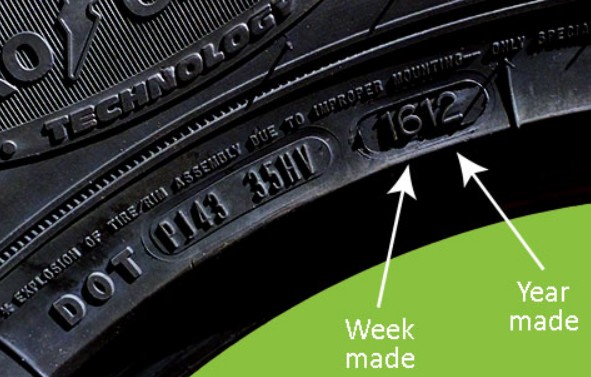How Long a Tire Lasts and When To Replace Them
How Long a Tire Lasts depends on its age and 5 other factors
Tires have a limited life in terms of age and wear. How long a tire lasts depends on when it was made and 5 other factors.
When tires get old, they have to retire (ugh, sorry)
Maximum tire life is 10 years from the date of manufacture.  Some carmakers like Ford, Nissan and Mercedes recommend replacing them six years after their manufacture date, regardless of the tread depth. And the six year mark is becoming the industry standard for when to replace tires.
Some carmakers like Ford, Nissan and Mercedes recommend replacing them six years after their manufacture date, regardless of the tread depth. And the six year mark is becoming the industry standard for when to replace tires.
Just to be clear, they’re talking about the manufacture date, not the day you installed them on your vehicle. The distinction is important because some odd-sized tires can sit in storage at the distributor’s warehouse for several years before being installed on your vehicle. The clock starts ticking the minute they’re manufactured.
Tire manufacturers Continental and Michelin recommend replacing tires at 10 years, regardless of remaining tread life.
Why there’s disagreement on tire life
Because there’s really no way to know how the tire has been stored or how it’s been maintained by the user. High heat, sunlight, UV exposure, ozone, underinflation, and non-use will age a tire more rapidly.
Heat and sunlight age tires faster
According to NHTSA research, tires age more quickly in warmer climates. The research also shows that exposure to sunlight and coastal climates speeds up the aging process.
Non-use ages them
This seems counterintuitive, but rubber compounds contain additives to fight the aging caused by UV and ozone. Driving actually activates the additives, while non-use reduces the effectiveness of the additives.
The average driver puts on 12,000 to 15,000 miles per year. Tread life is usually in the 30,000 t0 60,000 mile range, so most can easily last for six years. But its actual life is dependent on the rubber’s hardness, tread design, type of roads its used on, whether the vehicle is properly aligned and how well you maintain the air pressure. How you drive also affects how long tires last.
• A harder rubber compound will wear slower than a softer compound. But generally speaking, it will provide worse traction in snow and ice conditions (although some modern rubber compounds with added silica can improve cold weather traction.
• An aggressive tread design can sometimes wear faster than a less aggressive tread design.
The five factors that affect how long a tire lasts
1) The tire rubber compound determines how long a tire lasts
In years past, tires with higher treadwear ratings were made with harder rubber compounds to resist wear. Unfortunately, harder rubber provides less traction, especially on wet and icy roads. Modern tire designs are different. They use a softer rubber that’s filled with silica additives and other synthetic materials that provide better traction and longer life. In addition, they use the most up-to-date tread designs to increase grip, without causing extra noise and wear. Those tires generally cost more than tires made with a softer rubber compound.
2) Tire pressure, alignment, and shock/strut condition affect how long a tire lasts
Running your tires in an over/under-inflated condition causes accelerated tire wear and greatly reduces how long tires last. Mis-alignment issues like excessive camber and toe cause uneven tire wear, forcing you to replace tires long before the remainder of the tread is low. Worn shocks and struts also cause accelerated tire wear
3) Drivetrain design is a factor in determining how long a tire lasts
The front tires on a front-wheel-drive (FWD) car generally wear faster than the rear tires. That’s because they not only move the vehicle but also carry the weight of the engine and transmission in addition to performing all the steering and braking. If you own a FWD vehicle, you should rotate your tires according to the tire or car maker’s recommendations to even out the wear on all four tires.
The tires on rear-wheel-drive (RWD), four-wheel-drive (4WD) and all-wheel-drive (AWD) tend to wear tires slightly less than the front tires on a FWD drivetrains.
4) Road conditions and terrain are a factor in determining how long a tire lasts
Paved roads are much easier on your tires than gravel and dirt roads. Gravel tends to damage the tread blocks on your tires, causing imbalance and accelerated wear. Also, driving in hilly or mountainous areas causes accelerated tire wear due to the much higher traction loads on the tread while climbing and descending steep roads.
5) Your driving habits are a factor in determining how many miles your tires last
Jackrabbit starts and heavy braking reduce tire life
©, 2022 Rick Muscoplat
Posted on by Rick Muscoplat